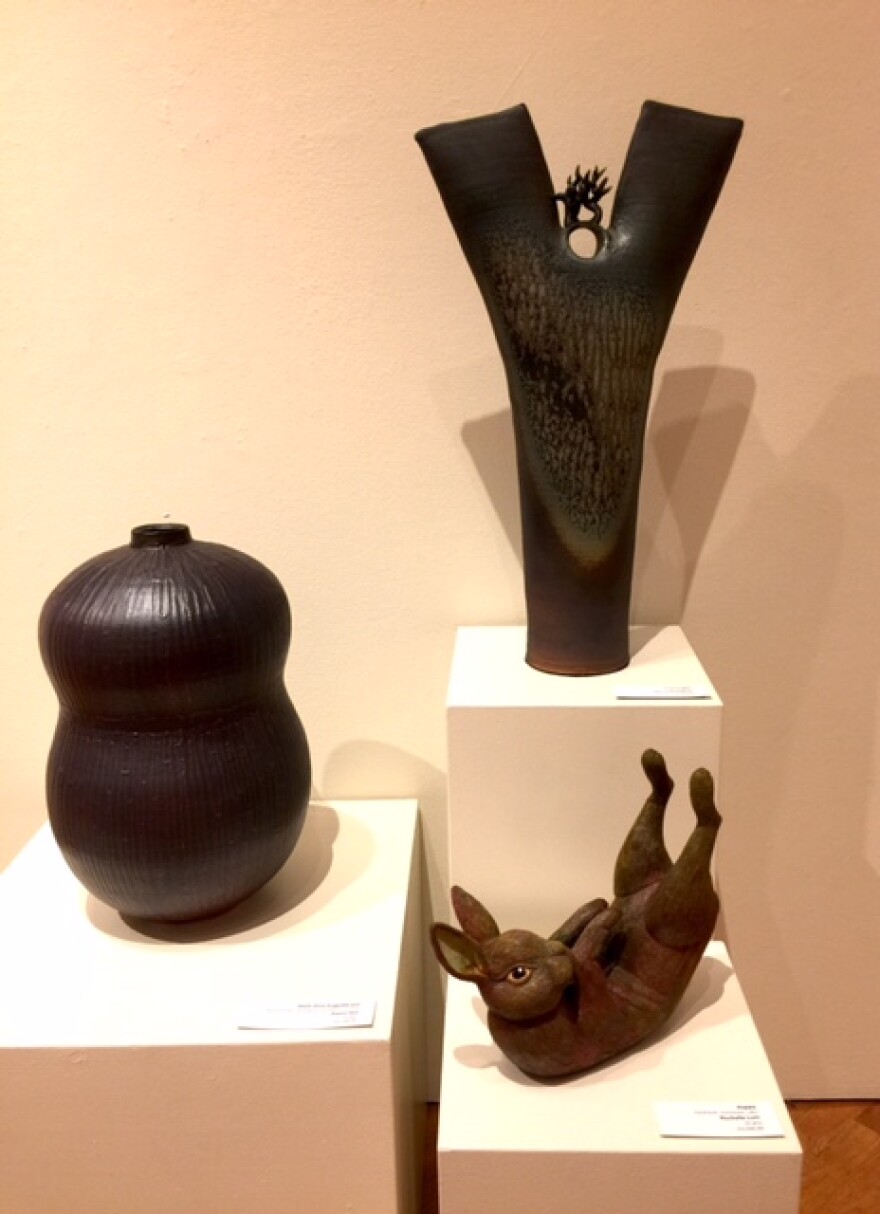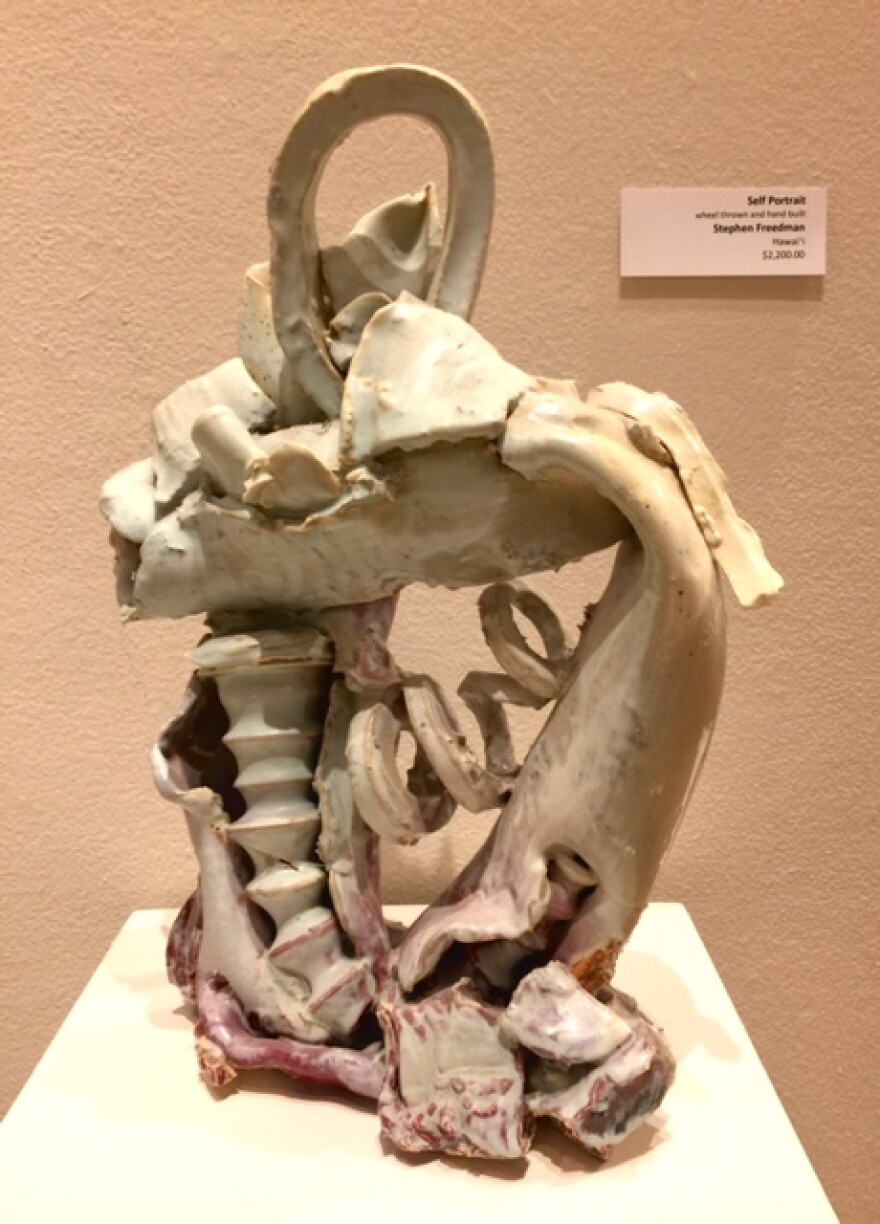Hawai‘i has a strong clay culture, and much of it is community based. The Hawai‘i Potters’ Guild, the Volcano Village Artists, Hui No‘eau, the L?na‘i Arts Center, and Kaua‘i Community College all play crucial roles keeping ceramics alive on their respective islands. Recently, the Moloka‘i Arts Center jumped in too, for people love to work with clay. HPR’s Noe Tanigawa reports on the first statewide juried ceramics exhibition.

Ceramics of Hawai‘i, the first statewide juried exhibition of ceramic art in Hawai‘i, welcomed over four hundred entries from every island except Lana'i. About a hundred pieces are in the exhibition, which continues at the Honolulu Museum School through January 8th. Organizers were able to award $1,850 in prizes, and three pieces were purchased by the Hawaii State Foundation for the Culture and Arts. Kuraoka says the awards prizes surpassed the national norm, and organizers hope to build upon them in the future.
The Hawai‘i Potters’ Guild at Church of the Crossroads is celebrating its 50th anniversary in 2017. Find out about classes and more about the Ceramics of Hawaii show at their website.

“The potters and ceramists, they’re a real ohana. They’re fun people," says Alice Leitner, one of the exhibit chairs for “Ceramics of Hawai‘i.”
"We love potluck. It’s a real community, as opposed to say, for instance, the painters, who like to be in their own little studio and paint. The potters and ceramists, its got a real community feeling about it. This show kind of brought everyone together. Everyone worked real hard to get their pieces in.”
Leitner says the purpose of this statewide first is to link ceramics communities and showcase the work that has been developing here for decades, H?w? to Hanalei. The juror for the show is a Kaua‘i based ceramist, David Kuraoka, internationally recognized and recently retired head of ceramics at San Francisco State.

Kuraoka: “The new trends at the universities and on the mainland, edgy kind of people, they don’t necessarily
celebrate the process of ceramic like we did. I do. I still do, and it’s still a mystery to me. And every time I get cocky, something broke. So then I buckle down, it keeps me on my toes because it breaks. If there’s no accident and mistake, there’s no growth. An accident happens and in a weird way, and if you look at it, it can change you. I mean I always change by my accidents. If you get it down and every time come out all time good, that’s it, you stop growing, kind of. I like the accidents, I like the mistakes, and clay does that.“
“I notice in grad schools, they think it’s process and process is low class or something of the 20th century. The 21st century they want it to be other than process, and ceramic is so heavily process. They can do that in sculpture, painting, printmaking, they can put junks together, or glue feather and McDonald paper, you know they can make this kinda new art with non-art materials and have fun. But ceramic is ceramic. We have a 200,000 year history of ceramic, so that’s kind of mind boggling but also, it is ceramic. I cannot change it. They can try, and then I think it bounces back because it affects so many different cultures.”

“Of course we have plastic cups, plastic jars, so we’re not important anymore. We’re not holding the water, we’re not holding the food, we have plastic now. But we can fulfill a different function. I agree, in the 1970’s, ceramics in Hawai‘i was much more dynamic. And I’m not sure why, I’m trying to think that over. Was it Horan? Was it the University? There was no electric wheel this side of the Rocky Mountains before 1946, everything slowly has moved over. It’s a very new thing. When it was real new, I think everybody was enamored and it was more important, I hate to say it, but maybe there’s too many people doing it now. I don’t know. We certainly didn’t drag along our collectors, there are no real galleries. It was a whole different group then, very active, just encourage, encourage, encourage, just totally encouraged me to do ceramics. ”
Much of ceramic history is represented in this show, with echoes of pre-Columbian pottery all the way through Asian ceramics to contemporary low fire techniques with brilliant metallic over glazes.
Leitner: “He (Kuramoto) would take a look at a piece like this and he literally would go, “How is the bottom

trimmed? Is it done well? You see that little speck here, that shouldn’t be there.” He said he feels this is something that people in Hawai‘i should learn. Because I kept saying, David, we’re local people , you know, it’s okay. You gotta encourage. He goes, “No, they need to know quality and standards,” and I understand how he feels as an artist, too. Try to have all of us achieve a certain standard.”
Kuraoka: “I believe they have to reach out of Hawai‘i more, do Café (the online artists’ listing), enter shows outside of the state, read more magazines, and go to the clay conferences. Better go to the California clay conferences, you have to go because so many things change in ceramics. Everything changes because all these young hot shots, I watch Instagram, I watch people and they’re all growing. I’m on Kaua‘i laying down and going, god, I’d better hurry up!”
Kuraoka says, do Café---the online artists’ listing. He wants Hawai‘i potters to submit works to national shows now.
“And then you’re going to get beat up. And then you’re

going to see what’s in the show and you’re going to get better next time. It just takes practice, you know, then we can be a part of a larger community, and we should be.”
A local bastion of ceramic creativity, the Hawai'i Potters' Guild based at Church of the Crossroads, is celebrating its fiftieth anniversary in 2017, part of the impetus for this show. Diana Tusher and others lovingly compiled notes to reconstruct the history of local ceramics. There are works are by seminal artists, Claude Horan, and Harue McVay, both influential professors at UH Manoa, as well as Toshiko Takaezu,. celebrated Honolulu potter who influenced generations at Yale. On the wall, a piece by Isami Enomoto of Ceramics Hawai'i, the fabled supply shop in 'Iwilei.





